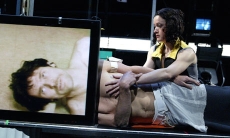Clay Lord has written a provocative and rather erudite post, The Work of Presentational Art in the Age of On-Demand Technological Empowerment, in which he cautions that as arts organizations embrace or respond to pressure to record and disseminate their live work that they not lose their identity and the core of what live performance (and theater in particular, perhaps) is all about.
Clay mentions my post from last week in which I wrote: “If our goal for the next century is to hold onto our marginalized position and maintain our minuscule reach—rather than being part of the cultural zeitgeist, actively addressing the social inequities in our country, and reaching exponentially greater numbers of people— then our goal is not only too small, I would suggest that it may not merit the vast amounts of time, money, or enthusiasm we would require from talented staffers and artists, governments, foundations, corporations, and private individuals to achieve it.” In response, Clay comments, “I’m not sure I can simply agree, much as I might want to. This, more than anything, reminds me of Veruca Salt, forever simply wanting more without pausing to ask whether that was going to truly get her someplace she wanted to be at the end.â€
My encouragement towards reaching greater numbers of people through other channels (generally and in the post quoted) is not meant to be a rejection of the importance and distinctive joy of an intimate, high quality, live arts experience. Those opportunities exist in great numbers in many cities in the US, for those interested and able to attend. But perhaps a personal anecdote will help to illustrate my excitement over the possibilities of recording and streaming live performances.
Despite being a ‘theater person’ I did not encounter the Wooster Group until I was in my 30s when I was working at On the Boards. Why? Because the Wooster Group didn’t travel to Kansas City when I was in graduate school. Or Idaho, when I moved there in my 20s to work in theater and run a music festival.The Woosters have never traveled to more than a select number of cities in the US (for perhaps obvious reasons). I had read about the Woosters in my edition of Brockett back in the late 80s/early 90s (a few paragraphs, as I recall) but never experienced ‘that kind of theater’. When I finally saw the Woosters, live, in my 30s, it was a seminal experience.
The same with Anne Bogart, Miranda July, Felix Ruckert, John Moran, Deja Donne, Richard Maxwell and many other artists that I was fortunate to encounter only because I had the good fortune to live in Seattle and work at On the Boards and, in particular, with Lane Czaplinski. Eventually, I moved to NY and saw 150 performances per year and it was a pretty heady period of my life. And now I’m living in a small village in the Netherlands and for many reasons (financial limitations because I’m a student, transportation issues, family obligations, etc.) it is quite difficult for me to see even the great work that is happening here in the Netherlands, much less venture to various festivals around Europe. No more Wooster Group for me.
Thus, I am (now more than ever) incredibly enthused that (for example) the the Metropolitan Opera broadcasts and OtB TV now exist. I wish to God OtB TV existed in 1990 when I was trying to find a place for myself in the arts world and develop an aesthetic. If I were running an arts aministration or MFA program of any kind I would make such broadcasts/channels mandatory viewing. When I was in graduate school one of my professors screened a film of Laurie Anderson’s UNITED STATES LIVE. I had not yet seen Laurie Anderson live. It prompted me to buy a ticket to her next concert, in Lawrence, Kansas. That, too, was a seminal experience for me.
Enough with the nostalgia … Yes, hold onto the core. But, to be honest, I think the ‘core’ of theater is far more threatened by the preponderance of rather deadly small-scale teledramas that pass as ‘dynamic live theater’ in many of the regional theaters in the US than by, for instance, a broadcast of the fabulous Young Jean Lee’s SHIPMENT on OtB TV.
If the ‘live’ experience is still mattering to people I believe it will compel people to go to the theater, buy a ticket (or stand in line for free tickets) and attend in person. But I would implore you not to dismiss these mediated experiences by assuming that they still generally ‘look like shit’ (as Clay suggests in his post and as they mostly did in the 20th century). Have you seen one of the Met HD Broadcasts? Personally, I think they are amazing and, as a ‘theater person’, I prefer them to the live experience as I can see the faces of the performers. Furthermore, having seen the broadcasts I now find the live experience all the richer. Not only is the technology improving but so are our skills at capturing the ‘liveness’ in a digital medium. And OtB TV is showing us that it can be done well without the price tag of the Metropolitan Opera broadcasts.
The major institutions in this country are now quite large and hungry beasts, demanding incredible resources to be sustained. It is quite hard for me to imagine how we can continue to justify such expenditures in the face of the declining live audience trend (that seems to have begun in the 80s according to the various studies). But if we could begin to talk about a rising ‘online’ or ‘cinema’ or ‘DVD’ audience (which the Metropolitan Opera and others have been able to do) then I begin to see the logic of ongoing large investments in these institutions. And these recordings are not just about reaching audiences that can’t access the live work. Arguably, they could play a crucial role in helping artists (more easily or quickly) build a larger global audience, be ‘in dialogue with’ other artists, and have greater impact.
We can also avoid that path, preserve the current experience, and hunker down with the goal of serving the people that (again) have the interest and ability to join us at our venues. But if that’s the case then we probably need to be prepared to downsize our infrastructure over time if the audience for what we do continues to diminish over time.
I would argue that if organizations with the potential for wider reach (that is, they are producing work for which there is demand beyond their local community) can do it well, and affordably, and strategically, and ethically (paying artists their fare share), then they should embrace the possibility of mediated experiences, trusting that they can live side-by-side with the live performance (and decades of recordings by musicians that primarily make their money doing live concerts should give us some hope here). Or even better, that new, exciting art forms may emerge (think Dance on Film) geared especially to the medium.
While the recording may be a substitute for some, I also believe it will be a complementary good for others. Do I think that if mediated experiences grow in number and reach that we will necessarily maintain our current (some would say ‘overbuilt’) infrastructure in the US? I don’t. But like others, I think that some of that infrastructure needed to be dismantled anyway – long before the Met broadcasts disrupted our sector.
If I had seen a recording of the Wooster Group in my 20s I would have beaten a path to NYC or the next nearest city where they were performing to see them live. But I couldn’t conceive of what that experience would be before seeing it. (I was trying to place the Woosters within my rather limited LORT theater experiences.) That is, after all, why we call them experience goods. Giving more people an experience (even if it is a mediated experience) is better in my mind than having them sit outside the venues wondering what goes on inside or, even worse, being pretty sure they know and that they wouldn’t find it interesting.
POST SCRIPT: Coincidentally, I just came across an email about an opportunity to experience the Wooster Group on film and video. Anthology Film Archives are hosting a 7-day series that ends on the 23rd. Info here.
If you’re still awake at the end of this post (sorry for the length) grab a cup of coffee and make the time to read Clay’s thoughtful post as well as truly smart comments by Polly Carl and Linda Essig.



